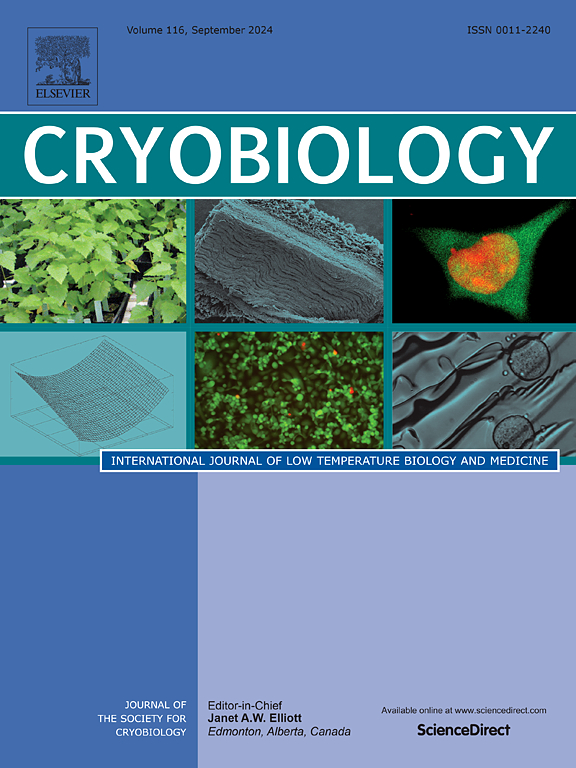提高封装肝细胞疗法低温保存技术的低温生物学方面。
IF 2.3
3区 生物学
Q2 BIOLOGY
引用次数: 0
摘要
为了有效地提供细胞疗法,必须以临床规模迅速提供治疗,含有足够的活性细胞成分(生物量),并遵守多种监管要求。冷冻保存可以更容易地满足这些要求。在此,我们介绍了大容量(2.5 升)藻酸盐包裹的肝细胞球(AELS)的冷冻保存和回收,这种肝细胞球适合与新型生物人工肝设备(HepatiCan™)一起使用,用于治疗急性肝衰竭(ALF)患者。通过首先使用热模拟器评估大规模冷冻袋的热曲线,研究了同时冷冻保存患者全部剂量(3 个冷冻袋,每个含有 833 毫升生物质)的可行性,从而可以对细胞功能恢复进行小规模测试,随后再进行大规模测试。本文介绍的工作表明,通过这些大容量冷冻袋可以实现优化的可重复冷却和升温曲线,从而在临床上实现高生物质回收率。回收的 AELS 还具有很高的再生潜力,可在 3 天内达到冷冻前的全部存活细胞密度,这表明细胞疗法可迅速用于 ALF 患者。这项研究提出了快速提供大容量细胞疗法的可行性,同时还需要进一步研究如何提高解冻后恢复的速度。本文章由计算机程序翻译,如有差异,请以英文原文为准。
Cryobiological aspects of upscaling cryopreservation for encapsulated liver cell therapies
For the efficient delivery of a cell therapy a treatment must be provided rapidly, at clinical scale, contain a sufficient active cellular component (biomass), and adhere to a multitude of regulatory requirements. Cryopreservation permits many of these demands to be met more readily. Here we present the cryopreservation and recovery of large volume (2.5L) alginate encapsulated liver cell spheroids (AELS), suitable for use with a novel bioartificial liver device (HepatiCan™) for the treatment of those suffering from acute liver failure (ALF), in regulatory approved cryobags and a cryopreservation process optimised for large volumes. By first assessing the thermal profiles of large scale cryobags with a thermal mimic, the feasibility of cryopreserving a full patient dose simultaneously (3x cryobags containing 833 ml biomass each) was investigated, allowing for small and subsequently large-scale testing of cellular functional recoveries. Work presented here demonstrates that optimised reproducible cooling and warming profiles could be achieved with these large volumes, leading to high biomass recoveries at full clinical scale. The recovered AELS also had high regeneration potential, achieving full pre-freeze viable cell densities within 3 days, indicating that the cell therapy could be delivered rapidly to patients with ALF. This study has presented the feasibility for rapid delivery of large volume cell therapies, whilst further research into improved speed of post-thaw recovery is warranted.
求助全文
通过发布文献求助,成功后即可免费获取论文全文。
去求助
来源期刊

Cryobiology
生物-生理学
CiteScore
5.40
自引率
7.40%
发文量
71
审稿时长
56 days
期刊介绍:
Cryobiology: International Journal of Low Temperature Biology and Medicine publishes research articles on all aspects of low temperature biology and medicine.
Research Areas include:
• Cryoprotective additives and their pharmacological actions
• Cryosurgery
• Freeze-drying
• Freezing
• Frost hardiness in plants
• Hibernation
• Hypothermia
• Medical applications of reduced temperature
• Perfusion of organs
• All pertinent methodologies
Cryobiology is the official journal of the Society for Cryobiology.
 求助内容:
求助内容: 应助结果提醒方式:
应助结果提醒方式:


